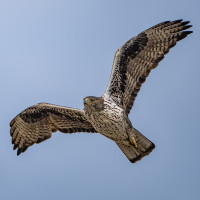Description
A long cycle route starts here but of more interest to birdwatchers is the convenient c4-5 km circular walk through pine woods to a ridge and back down to the main track. The woodlands hold Pitulice de munte and Pițigoi moțat, open areas have Presură de munte, Presură bărboasă and Ciocârlie de pădure and the low scrub a variety of ‘Sylvia’ warblers such as Silvie de câmp, Silvie mediteraneană and Silvie de tufiș. As with all footpaths beside the A 381 this is a good location to look for raptors particularly in spring and autumn when Acvilă mică, Gaie neagră, Viespar and the odd Hoitar (plus Barză neagră) pass through. Șerpar (spring-autumn), Vultur sur , Uliu păsărar and Șorecar comun frequently appear but if you're lucky you may spot Acvilă porumbacă or Uliu porumbar here. During passage periods expect Prigorie and pretty much any small passerine migrant.
Details
Access
Take Exit 66 off the A 381 and then the service road south for just under 2km and pull over on to a dirt track on your left to explore the signposted Sendero La Teja Park and follow the paths.
Terrain and Habitat
Forest , Scattered trees and bushes , MountainConditions
MountainousCircular trail
YesIs a telescope useful?
NoGood birding season
Spring , AutumnBest time to visit
Spring migration , Spring , Autumn , Autumn migrationRoute
Unpaved road , Narrow trailDifficulty walking trail
StrenuousAccessible by
Foot , BicycleBirdwatching hide / platform
NoExtra info
The tracks here provide a variety of 'pan handle' walks from 4 km upwards allowing you to tailor your walk to your individual requirements most of the walks are fairly easy but there are several steep sections. Look out for various orchid species and the local Portuguese Sundew (Drosophyllum lusitanicum) which, unlike sundews in northern Europe, has attractive pale yellow flower making it easy to locate.





